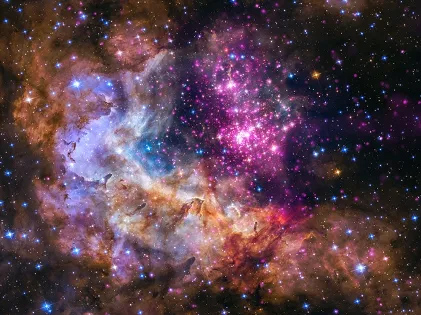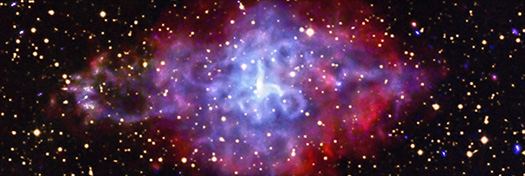Submitted by chandra on Tue, 2024-08-13 12:39
Submitted by chandra on Tue, 2024-07-23 15:12
Twenty-five years ago, the Space Shuttle Columbia launched into space carrying the Chandra X-ray Observatory. Press releases from the Chandra X-ray Center, CfA, and Smithsonian shared 25 new images with Chandra data to publicize this momentous milestone. A dedicated webpage to Chandra’s 25th birthday, plus the new images and press release, can be found at https://chandra.si.edu/25th/
Submitted by chandra on Mon, 2024-07-22 12:04
This montage contains 25 new images with data from NASA’s Chandra X-ray Observatory that is being released to commemorate the telescope’s 25th anniversary in space, as described in our latest press release. Since its launch into space on July 23, 1999, Chandra has been NASA’s flagship mission for X-ray astronomy in its fleet of “Great Observatories.” Chandra discovers exotic new phenomena and examines old mysteries, looking at objects within our own Solar System out to nearly the edge of the observable Universe.
Submitted by chandra on Thu, 2024-07-18 14:00
Submitted by chandra on Thu, 2024-07-11 10:11
The guest blogger for this post is our own Dr. Kimberly Arcand, Visualization Lead and Emerging Technology Scientist for the Chandra X-ray Center. Kim has been working with Chandra since before the telescope’s launch and has been at the forefront of bringing Chandra data to the public in innovative ways. Some of her recent collaborations include the Chandra sonification project. In addition to being a NASA project, Chandra is also part of the Smithsonian Institution (the telescope is operated by the Smithsonian Astrophysical Observatory in Cambridge, Mass.) That connection led to a new collaboration, described below, between Kim and Mickey Hart, the Grateful Dead, and Dead and Company, drummer and artist.
 Westerlund 2
Westerlund 2
Credit: NASA/CXC/SAO & NASA/STScIThere is an inherent connection between music and space. There’s no rift between science and art, just a riff. They are two sides of the same coin, more alike than different.
Submitted by chandra on Tue, 2024-07-09 14:54
Credit: MACS J0416.1-2403: X-ray: NASA/CXC/SAO/G. Ogrean et al.; Optical/Infrared: (Hubble) NASA/ESA/STScI; IR: (JWST) NASA/ESA/CSA/STScI/Jose M. Diego (IFCA), Jordan C. J. D'Silva (UWA), Anton M. Koekemoer (STScI), Jake Summers (ASU), Rogier Windhorst (ASU), Haojing Yan (University of Missouri); Orion Nebula (M42): X-ray: NASA/CXC/SAO/E. Feigelson; IR: NASA/ESA/CSA/STScI; Image Processing:NASA/CXC/SAO/L. Frattare and J. Major; NGC 3627: X-ray: NASA/CXC/SAO; Optical: NASA/ESO/STScI, ESO/WFI; Infrared: NASA/ESA/CSA/STScI/JWST; Image Processing: NASA/CXC/SAO/J. Major; Rho Ophiuchi: X-ray: NASA/CXC/MIT/C. Canizares; IR: NASA/ESA/CSA/STScI/K. Pontoppidan; Image Processing: NASA/ESA/STScI/Alyssa Pagan, NASA/CXC/SAO/L. Frattare and J. Major
It’s time to take a cosmic road trip using light as the highway and visit four stunning destinations across space. The vehicles for this space get-away are NASA’s Chandra X-ray Observatory and James Webb Space Telescope.
In each of the images, which add Chandra data to previously released Webb images, the colors represent different wavelengths of X-ray, optical, or infrared light.
Submitted by chandra on Fri, 2024-06-28 13:34
On Saturday, June 22, Chandra’s 25th anniversary shone as part of the Smithsonian’s Cosmic Journey initiative, with events across SI's Solstice Saturday. During Solstice Saturday, SI museums on the Mall stay open late and host special programs and performances.
The event drew record-breaking audiences with many tens of thousands of people over the course of the day, braving the DC heat to enjoy a day and evening of astronomy.
Chandra content was featured at multiple museums including Air & Space, Natural History, Arts & Industries, African American History & Culture, and Hirshhorn, for example. The installations included Chandra sonifications and large scaled image projects, trivia, handouts, 3D prints, and a documentary world premiere of "Listen to the Universe" from Chandra and NASA+.
Submitted by chandra on Thu, 2024-06-20 09:57
 3C 58
3C 58
Credit: X-ray: NASA/CXC/ICE-CSIC/A. Marino et al.; Optical: SDSS; Image Processing: NASA/CXC/SAO/J. Major
The supernova remnant 3C 58 contains a spinning neutron star, known as PSR J0205+6449, at its center. Astronomers studied this neutron star and others like it to probe the nature of matter inside these very dense objects. A new study, made using NASA’s Chandra X-ray Observatory and ESA’s XMM-Newton, reveals that the interiors of neutron stars may contain a type of ultra-dense matter not found anywhere else in the Universe.
In this image of 3C 58, low-energy X-rays are colored red, medium-energy X-rays are green, and the high-energy band of X-rays is shown in blue. The X-ray data have been combined with an optical image in yellow from the Digitized Sky Survey. The Chandra data show that the rapidly rotating neutron star (also known as a “pulsar”) at the center is surrounded by a torus of X-ray emission and a jet that extends for several light-years. The optical data shows stars in the field.
Submitted by chandra on Wed, 2024-06-19 11:16
Our guest blogger this week is Jessica Jacyno. Jacyno is an engineering student at Brown University from Sweetwater, Tennessee. She is passionate about the interplay between international policy and science.
As an engineering student, I am taught to take advantage of the laws of physics to accomplish humanity’s goals. Before that though I am a student of the cosmos, intent on staring up at the night sky to unravel the secrets of our origins. Until taking classes on astrophysics at university, my focus had always been on the results, not the tools used to achieve such results. Telescopes always seemed like complex black boxes that were out of my paygrade to understand. After all, if they were producing discoveries why did I care how they were found?
However, learning about these means of discovery is akin to learning about the history of the past to inform our present. Not only is the technology deeply intriguing (and not as unfathomable as you would think), but there is much to be learned from the way in which complex problems like space visualization are approached and solved. These approaches and solutions should serve to inform every type of problem solving across disciplines that requires critical thinking.
Submitted by chandra on Wed, 2024-06-12 09:56
This graphic shows a three-dimensional map of stars near the Sun. These stars are close enough that they could be prime targets for direct imaging searches for planets using future telescopes. The blue haloes represent stars that have been observed with NASA’s Chandra X-ray Observatory and ESA’s XMM-Newton. The yellow star at the center of this diagram represents the position of the Sun. The concentric rings show distances of 5, 10, and 15 parsecs (one parsec is equivalent to roughly 3.2 light-years).
Astronomers are using these X-ray data to determine how habitable exoplanets may be based on whether they receive lethal radiation from the stars they orbit, as described in our latest press release. This type of research will help guide observations with the next generation of telescopes aiming to make the first images of planets like Earth.
Pages
